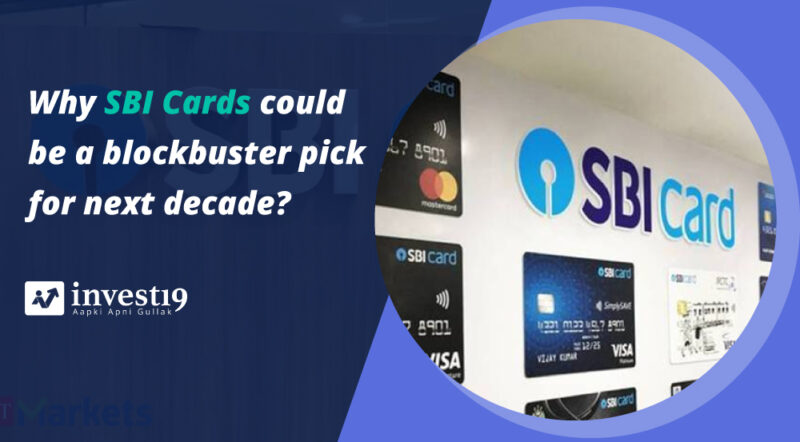About the Company
In 1998, when Indian stock market and SBI was reviving from the Harshad Mehta scam, SBI Cards decided to enter into credit card space keeping in mind the potential of credit card business in 21st century. The SBI Cards reached to 1 lakh cardholders in a period of one year and 1 million holders in 2002 and after collaboration with Indian railways, there is no looking back for it. The company is the second largest card distributor in India after HDFC Bank and first one to list on the Indian bourses. Currently, the company has more than 10 million customer base and has captured 18% of the total market share in India.
Growth Drivers of SBI Cards
- Less penetration in card segment: If someone will scrutinize the total cardholder with total population in India, one will figure out that India accounts only three credit cards against every 100 people. US economy has 320 credit cards against every 100 people, which shows the gap that has yet to be filled by credit card disbursing companies.
- Increase in Co-Branding: The company has partnered with Spice Jet, Tata, Etihad, Apollo, IRCTC and American Express to increase their scope through other corporate branding. This will advocate their interest income and commissions continuously. It’s recent co-branding with India’s largest merchant banking app Paytm as a Paytm SBI Card shows how rigorously the SBI Card is approaching to cater the untapped volumes in the economy.
- Rising Trends in E-commerce platforms: The emergence of e-commerce platforms in India has raised the demand of credit cards as they offer fancy discount offers in addition with short term advances. No matter which kind of e-commerce platform is, payment gateway will definitely provide the option of credit card.
- Strong parental support: The parent company SBI has strong presence in the Indian banking system. This may facilitate SBI Cards in availing cheap credit for longer period. Moreover, the strong presence of SBI will continue to provide a healthy customer base.
- Oligopoly structure in unlisted space: One may not see any monopoly structure in any kind of industry after privatization and disinvestment have been favored by government to hang the prices of goods on demand-supply mechanism. Credit card distribution institutions have limited control over pricing of the offering due to high entry barriers, which put them on the driving seat,
- Monopoly structure in listed space: Listed companies with no rivals enjoy high premium on the Indian bourses as investors keep an eye over these kind of business.
Must Read: Burger King India IPO Will Hit The Primary Market On December 02. Should You Subscribe?
Financials
- Compounded Annual Growth Rate: The future stream of cash flows of any institution banks upon their stream of cash flows from their direct revenues. SBI Cards has generated the revenues at a CAGR of 36% in last five years that includes revenues from direct operations (loans and advances) and other income through commissions on usage of credit cards for purchases.
- Net Interest Income: Considering the FY20 numbers as they are unaffected from Covid-19 pandemic, the institution has reported interest income at 4,841.3 crores while the interest expanded was landed at 1,300.9 crores which mark a 272% of whooping difference in NII numbers. The company has reported 3,978.6 crores inflow from fees and commissions, which clearly states that usage of credit card to shop on e-commerce platforms and other places is moving parallel with interest income.
- Net Interest Margins: The NIM margins of a financial institution determine their efficiency in generating net interest income from the assets, which are used for generating revenue from direct operations. The valuations of SBI Cards offers NIM (calculated by deducting net interest paid out to lenders from net interest earned by disbursing loans and investments, relative to the amount of assets that earns interest) margins at 16.14% much higher than the leading NBFCs Bajaj Finance and Shriram Transport which are operating with NIMs at 10.24% and 7.6% respectively. This ratio helps the bankers to analyze how well they have managed to earn on the assets, which can be provided for advances. Higher the NIM margins a bank has been able to generate, healthy will be the revenue generation capacity of the bank.
- Cost to Income Ratio: This ratio has a unique identity in the scrutiny of the balance sheet which clearly describes how well the management of the company has done their job in disbursing loans to the borrowers keeping in mind the attribute of cost reduction. The ratio is calculated by dividing the operating expenses with operating income (net interest income plus other income). As per the consolidated financial statements of the SBI Cards, the Cost to Income ratio stands at 56.6%. The ratio is higher in comparison with other NBFCs, which showers a little reason of worry.
Also Read: Why FMCG stocks are considered as defensives in equity markets?
